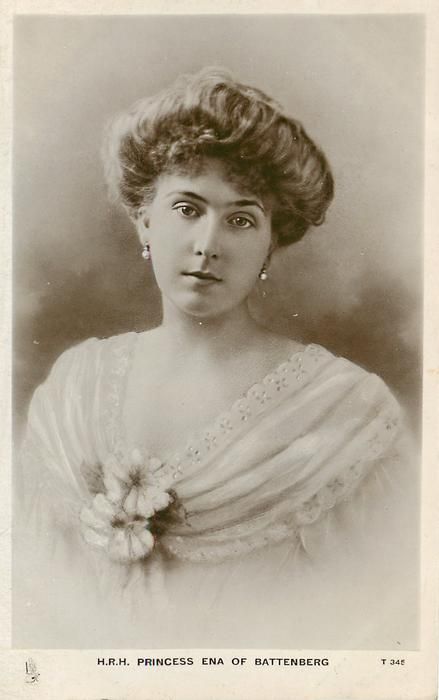Princess Ena of Battenberg
Queen Victoria's granddaughter married Alfonso XIII 116 years ago on 31st May
June 1905, and three years since Alfonso XIII had assumed full power as King of Spain . The posthumous son of Alfonso XII was proclaimed king at his birth in 1886, six months after the death of his father, and the crown had been held in regency by his mother, María Cristina of Hapsburg, until he reached majority at the age of 16.

Photo - Pinterest
The young king was in London that month on an official visit to the UK and on 5th June attended a dinner at Buckingham Palace held in his honour by Edward VII. At the dinner, a niece of Edwards’s caught the eye of the Spanish king: 17 year old Princess Victoria Eugenie of Battenberg, known to her family as Ena. A granddaughter of Queen Victoria, Princess Ena was the daughter of Princess Beatrice, Victoria’s youngest daughter, and Prince Henry of Battenberg.
Princess Ena was seen as having relatively low royal status, as her father was the product of what is known as a morganatic marriage –when a man of royal rank marries a woman of inferior rank, and the children of that marriage cannot inherit any of the father’s titles, rank or property. Princess Ena’s paternal grandmother had been born Countess Julia Hauke and her son Henry was excluded from his father’s line of succession and titles in the Grand Ducal House of Hesse.
Ena was born with the title of Serene Highness and, although elevated to the title of Highness by her grandmother, Queen Victoria, was still considered as lesser royalty. Another objection from King Alfonso’s mother was that Ena was a protestant, and there were concerns that she could be a carrier of haemophilia, as was her grandmother.
Princess Ena agreed to undertake instruction into the Catholic faith and was baptised a Catholic on 7th March 1906 in the Palacio de Miramar in San Sebastián. The royal engagement was officially announced two days later and, after Ena’s uncle, Edward VII, granted his niece the status of Royal Highness the following month, a marriage treaty was signed between Great Britain and Spain London on 7th May.
The wedding took place on 31st May 1906 at the royal monastery of San Gerónimo in Madrid. Victoria Eugenie’s cousin, the Prince of Wales and future King George V, was at the ceremony with the Princess of Wales, the future Queen Mary.
The New York Times, reporting on the day, describes the wedding procession when the royal coaches came into view as like ‘some illuminated page of a fairy-book’, each of the coaches drawn by eight ‘superb white horses with golden and silver harness and lofty-coloured plumage’. The king, they say, was in the uniform of a Field Marshall, and the bride ‘seemed to be robed in jewels’ as the silver embroidery of her wedding dress was reflected by the myriad of lights inside the Church of San Jerónimo in Madrid.
The king and his new queen were leading the procession back to the palace when an anarchist threw a bomb at the royal carriage. The bomb, hidden inside a bouquet of flowers, was thrown from the balcony of Number 88, Calle Mayor, and went off just at the side of the royal carriage. The royal couple escaped injury, but the missile caused 23 deaths and injured more than 100 people. The gala ball planned for that afternoon was cancelled as a mark of respect for the victims.
The couple had six children, and a seventh was stillborn. The fears of haemophilia were confirmed when their eldest son, Alfonso, was born with the condition in 1907, a year after their marriage. Their youngest son, Gonzalo, was also born a haemophiliac, and the couple’s second son, Jaime, lost his hearing after a childhood illness. Both he and his elder brother renounced their claim to the throne in favour of Alfonso XIII’s third son, Juan de Borbón y Battenberg, the Conde de Barcelona.
The royal family left Spain to live in exile in 1931 and Alfonso XIII abdicated in favour of the Count of Barcelona 10 years later, just over a month before his death in Rome. Ena died in Switzerland in 1969, the year after she’d returned to Spain after 37 years of living in exile, to attend the christening of her great grandson, Felipe VI de Borbón, the current King of Spain.
